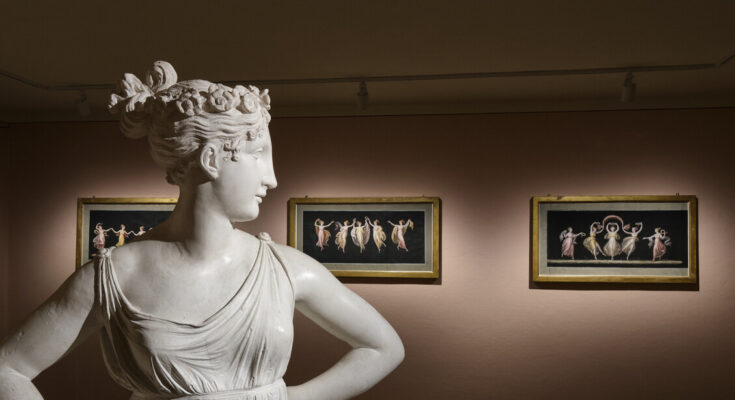(by Francesca Chiri) Regardless of the Italic genius, or the locus of genius, there is a small village at the foot of Monte Grappa, surrounded by a series of villages winding along the Venetian foothills, which seems to show how beauty can produce unimpeded artistic connections. It is called Possagno and is the town that gave birth to Antonio Canova: there, with the entrance to the pleasant town and opposite it a portico overlooking a garden and then a lush park, there is still the house where the sculptor was born and which still houses, in addition to the furniture, many of his paintings.
In the park, which is now part of the entire museum complex, stands Antonio Canova’s Gypsotheca, a place that preserves the sculptor’s historical and artistic legacy.
In the Gypsotheca Possagno, the largest in Europe, there are actually original plaster models from which marbles were taken that are currently found in the most important museums in the world. Built by the will of the bishop and scholar Giovanni Battista Sartori, the sculptor’s half-brother, his advisor and collaborator, keeper of his name and memory. It was he who took it upon himself after Antonio’s death to collect his brother’s legacy and preserve his traditions: in addition to completing the Temple of Possagno, a kind of Pantheon dominating the village that Canova desired and designed, he also built the beautiful Gypsoteca Canoviana. Considered a large basilica, lit from above by three large skylights, the Gypsoteca was bombarded and then restored in various stages. And think again. Therefore, in the mid-1950s, Venetian architect Carlo Scarpa was entrusted with expanding the building and reorganizing the works. It is a fortunate coincidence that today gives us the opportunity to admire together, in the small village of Treviso, the works and creative genius of the great Venetian sculptor and architect. Yang redesigned the first entrance hall and the new wing, which takes his name, and which allows zenithal light to highlight the white Canova plaster. Meanwhile, in the Gemin Wing of the Gypsotheca Museum, until January 11 2026, you can also see the exhibition dedicated to “Carlo Scarpa and art at the Biennale. Works and glass from the Gemin Collection”, namely the architect, long-time friend and collaborator of Carlo Scarpa for more than a decade. Not only that. A few kilometers from Possagno there is another magical place that leads to Scarpa.
The architect was deeply attached to the hinterland of Treviso: he liked to retreat to his home studio near Asolo and after his intervention in Possagno, from 1969, he worked on the Brion Tomb in San Vito di Altivole, where among other things the architect himself was buried after his death.
The Brion Memorial project was entrusted to Scarpa after the sudden death of Giuseppe Brion, founder and owner of Brionvega. This is Carlo Scarpa’s final work, among his most complex, original, important and valuable. A meditation spot in the garden open to everyone, where tombs emerge between canals with ponds covered with water lilies, is designed in geometric shapes reminiscent of Islamic paradises and Japanese gardens and combines architecture full of sophisticated symbols and hidden references from various cultures and religions.
Then, without arriving at Venice which hosts some ten of the architect’s iconic projects, just above the Pedemontana stands another symbol of the great designer: it was in fact he who was commissioned by Enrico Mattei for the construction of the church serving the visionary tourist complex desired in the Dolomites by the president of the Six-Legged Dogs for his employees. A construction made of equilateral triangles and a bell tower which, with its high steel spire, provides lightness and balance to the overall composition. A hidden and almost unknown masterpiece of religious architecture preserved among the larch and cypress trees of Borca di Cadore.
Reproduction protected by law © Copyright ANSA



